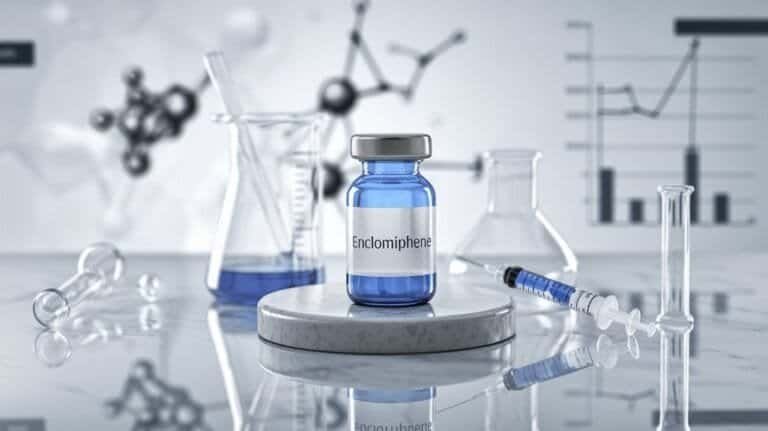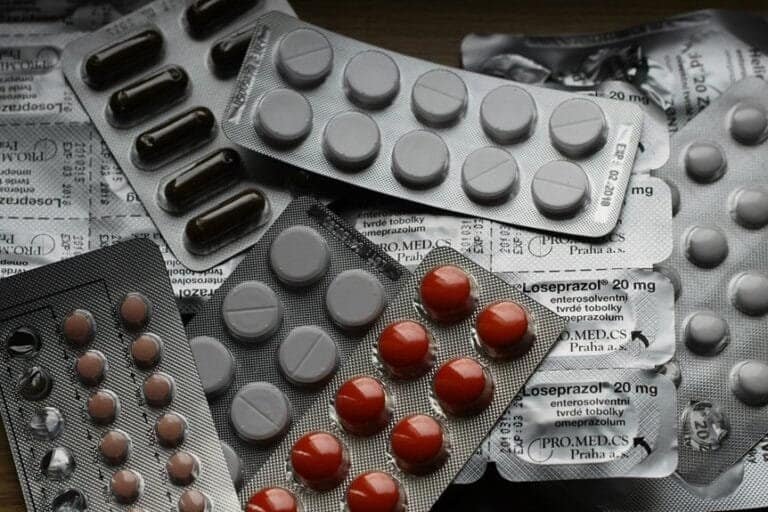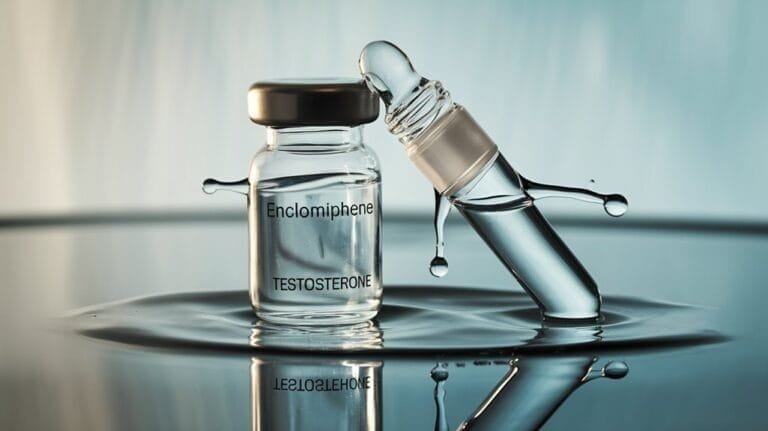Yes, Enclomiphene boosts testosterone by stimulating your body's natural production instead of delivering external testosterone. It works by blocking estrogen receptors, which increases your levels of gonadotropins like LH and FSH, promoting testosterone synthesis in the testes. Results show significant increases in testosterone, often reaching around 604 ng/dL after several weeks of treatment. Unlike traditional testosterone replacement therapy, Enclomiphene preserves fertility and hormonal balance, making it a safer option. You'll find more insights on its benefits and mechanisms.
Key Takeaways
- Enclomiphene blocks estrogen receptors, increasing gonadotropin-releasing hormone (GnRH) and stimulating testosterone production from the testicles.
- Testosterone levels can rise significantly, reaching up to 604 ng/dL after six weeks of treatment.
- Unlike traditional testosterone replacement therapy (TRT), Enclomiphene promotes natural testosterone production without compromising fertility.
- The average increase in testosterone during treatment is about 149.33 ng/dL, with effects potentially lasting several months.
- Enclomiphene has a favorable safety profile, minimizing side effects and maintaining semen parameters compared to TRT.
The Mechanism of Action of Enclomiphene
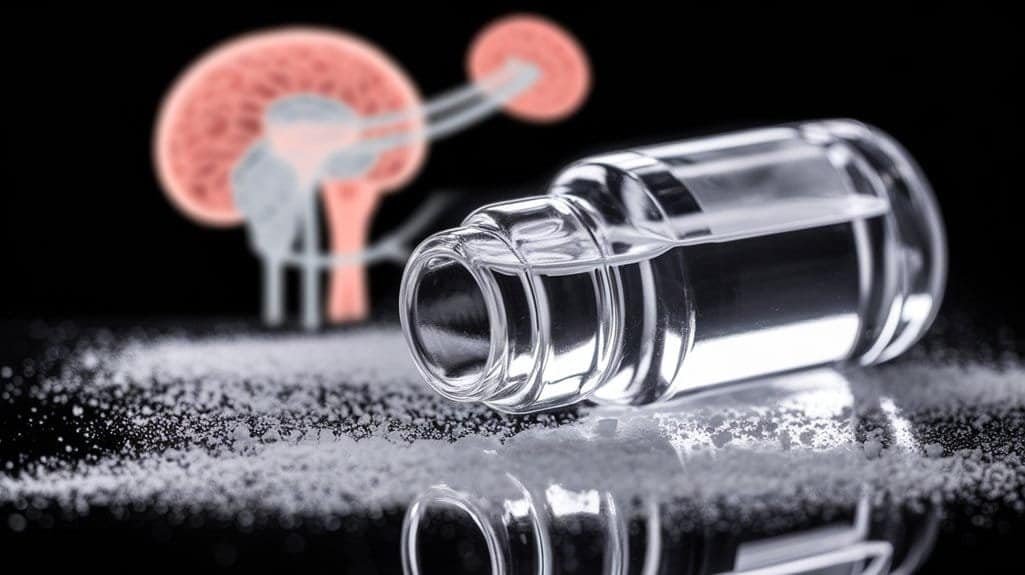
When considering the mechanism of action of enclomiphene, it's essential to understand how it interacts with the hypothalamus.
Enclomiphene blocks estrogen receptors, reducing estrogen's inhibitory effects on the hypothalamic-pituitary-gonadal (HPG) axis. This action increases the secretion of gonadotropin-releasing hormone (GnRH), which stimulates the pituitary gland, important for hormonal balance.
As a result, luteinizing hormone (LH) and follicle-stimulating hormone (FSH) levels rise, driving testicular function. Elevated LH fosters testosterone production in Leydig cells, while FSH enhances sperm production. Furthermore, enclomiphene preserves fertility while boosting natural testosterone levels, making it an ideal option for men with endocrine concerns.
Enclomiphene benefits men with secondary hypogonadism by preserving natural hormonal activity and promoting spermatogenesis without suppressing the body's endogenous hormonal processes. This distinction sets it apart from traditional testosterone treatments.
Changes in Testosterone Levels After Treatment
The interaction of enclomiphene with the HPG axis leads to notable increases in testosterone levels, particularly for men with hypogonadism. During treatment, you might notice significant testosterone fluctuations as levels rise and stabilize. Key findings include:
- Testosterone can increase to around 400 ng/dL within two weeks.
- After six weeks, baseline levels below 300 ng/dL can reach up to 604 ng/dL.
- Increases can persist for at least one week post-treatment and last up to three months.
- On average, testosterone levels rise by about 149.33 ng/dL during treatment duration.
These changes underline the effectiveness of enclomiphene in raising testosterone levels, offering a long-term solution for those struggling with low levels. Additionally, this therapy preserves endogenous testosterone production, which is a significant advantage over testosterone replacement therapy (TRT).
Enclomiphene vs. Traditional Testosterone Replacement Therapy

While both enclomiphene and traditional testosterone replacement therapy (TRT) aim to address low testosterone levels, they differ fundamentally in their mechanisms and outcomes.
Enclomiphene offers several advantages, primarily by stimulating your body's natural testosterone production instead of introducing external testosterone, as with TRT. This method preserves hormonal balance and sperm production, addressing concerns around fertility preservation. Furthermore, enclomiphene is particularly effective for men with persistent low testosterone due to secondary hypogonadotropic hypogonadism.
In addition, enclomiphene disrupts the negative feedback of estrogen on the hypothalamic-pituitary-gonadal axis, increasing luteinizing hormone (LH) and follicle-stimulating hormone (FSH) levels.
In contrast, TRT can lead to decreased spermatogenesis and potential infertility. As a result, enclomiphene may be a more desirable option for men wanting to boost testosterone levels without compromising fertility.
Impact on Hormonal Feedback Loops
When you take enclomiphene, it blocks estrogen receptors in the brain, particularly in the hypothalamus and pituitary gland.
This blockade disrupts the normal negative feedback loop that suppresses testosterone production, leading to increased secretion of gonadotropin-releasing hormone (GnRH).
As a result, your pituitary gland produces more luteinizing hormone (LH) and follicle-stimulating hormone (FSH), which are essential for testosterone production.
Estrogen Receptor Blockade
By blocking estrogen receptors in the pituitary gland, enclomiphene disrupts the normal hormonal feedback loops, leading to an increase in the production of follicle-stimulating hormone (FSH) and luteinizing hormone (LH).
This mechanism counteracts estrogen dominance and enhances receptor sensitivity, promoting natural testosterone production.
Here are key implications of this blockade:
- Increased LH and FSH levels stimulate testosterone synthesis in the testes.
- It reduces estrogen's inhibitory role in the hypothalamic-pituitary-gonadal axis.
- Enclomiphene balances testosterone pathways, avoiding excessive dihydrotestosterone (DHT) production.
- This targeted approach helps in restoring hormonal balance in men with secondary hypogonadism.
The net effect is a boost in both total and free testosterone, optimizing hormonal health.
GnRH Secretion Enhancement
Blocking estrogen receptors also leads to increased secretion of gonadotropin-releasing hormone (GnRH) in the hypothalamus.
This occurs because the disruption of estrogen's negative hormonal feedback allows for heightened GnRH regulation. As GnRH levels rise, they stimulate the pituitary gland to release more luteinizing hormone (LH) and follicle-stimulating hormone (FSH), which are crucial for testicular function.
Elevated LH promotes testosterone production in Leydig cells, while FSH supports sperm production. Consequently, this mechanism not only increases testosterone levels but also preserves fertility.
Clinical studies back this up, showing significant increases in LH and testosterone, demonstrating that enclomiphene effectively enhances hormonal feedback loops fundamental for restoring normal testosterone production and addressing hormonal imbalances.
Safety Profile and Efficacy of Enclomiphene
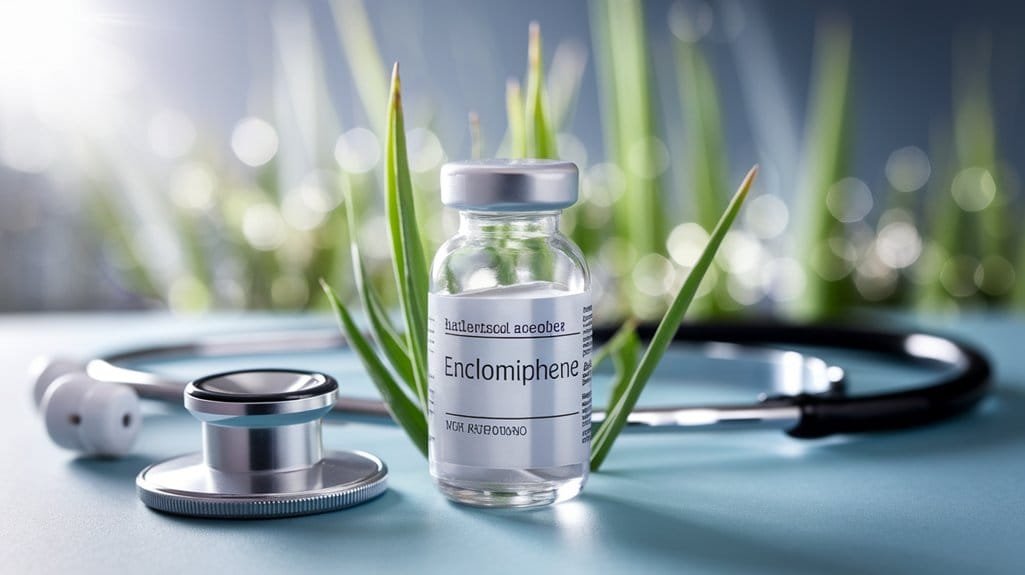
Enclomiphene demonstrates a favorable safety profile while effectively addressing low testosterone levels.
You'll find that it stimulates testosterone production without negatively impacting semen parameters.
Regular safety monitoring is essential to manage potential side effects. Here are four key points to reflect upon:
- Common side effects include headaches (3.3%), nausea (2.1%), and dizziness (1%).
- Serious side effects may include a risk of venous thromboembolism, particularly in individuals with a history of blood clots.
- Mood changes like irritability or aggression require close observation.
- Liver function should be monitored in patients with existing liver issues due to its metabolic pathway.
With appropriate safety monitoring, enclomiphene can serve as an effective treatment for low testosterone levels.
Clinical Studies Supporting Enclomiphene Use
While exploring treatment options for low testosterone, clinical studies consistently support the use of enclomiphene citrate due to its significant effects on testosterone levels and hormonal balance.
Research shows that enclomiphene benefits hypogonadal men by increasing total testosterone levels in a dose-dependent manner, with both 12.5-mg and 25-mg doses proving effective.
Importantly, morning serum testosterone levels were comparable to those achieved with topical testosterone, and the effects persisted for at least three months.
Additionally, enclomiphene enhances luteinizing hormone (LH) and follicle-stimulating hormone (FSH) levels, promoting a balanced hormonal profile.
Essential, unlike testosterone replacement therapy, it preserves sperm concentration, highlighting its clinical efficacy in maintaining fertility for men with secondary hypogonadism.
Considerations for Men With Secondary Hypogonadism

Maneuvering the complexities of secondary hypogonadism requires understanding both its causes and treatment options. Here are key considerations:
- Identify Underlying Causes: Look into issues with the hypothalamus or pituitary gland that may disrupt hormone production.
- Consider Lifestyle Modifications: Implement stress-reduction techniques like exercise and yoga, which can positively impact testosterone levels.
- Explore Enclomiphene: This treatment can enhance testosterone production while preserving fertility and testicular size, offering a safer alternative to testosterone replacement therapy (TRT).
- Monitor Fertility: Regular semen analysis guarantees peak recovery and can address male infertility effectively.
Frequently Asked Questions
Can Enclomiphene Be Used by Men With Normal Testosterone Levels?
Think of your body like a finely tuned car; even normal testosterone levels might not optimize performance. You can consider enclomiphene for subtle improvements, as it can enhance normal testosterone levels without disrupting balance.
What Are the Common Side Effects of Enclomiphene?
Enclomiphene side effects can include nausea, headaches, hot flashes, mood swings, and increased libido. These symptoms may indicate hormonal imbalance, requiring close monitoring to guarantee effective management and minimize potential complications during treatment.
How Should Enclomiphene Be Administered?
When it comes to administering enclomiphene, consistency's key. Follow your doctor's dosage recommendations, typically starting at 12.5 mg daily, and take it at the same time each day for ideal results.
Is Enclomiphene Effective for Treating Low Libido?
Enclomiphene's effectiveness for improving libido varies among individuals. While some experience enhanced sexual function, others may not notice significant changes. Factors like hormonal levels and overall health heavily influence these outcomes, so results can differ.
Can Enclomiphene Be Taken Long-Term Safely?
Research indicates that 88% of men achieve normal testosterone levels with enclomiphene. For long-term safety, follow dosage guidelines and monitor hormone levels regularly to mitigate potential side effects and guarantee effective treatment.



